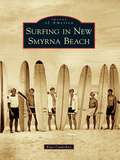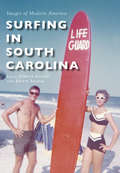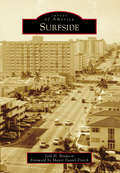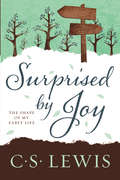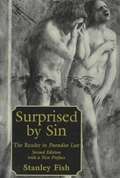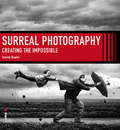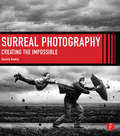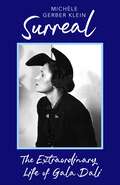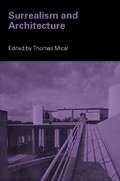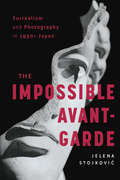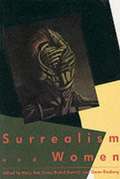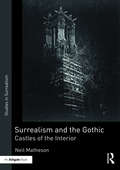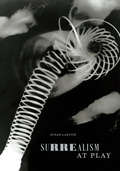- Table View
- List View
Surface Treatment Workshop: Explore 45 Mixed-Media Techniques
by Darlene Olivia Mcelroy Sandra Duran-WilsonBreaking the Surface Pondering how to begin a new piece of art? Surface Treatment Workshop has the answer! The authors of Image Transfer Workshop are back to show you 45 stepped-out mixed-media techniques that will add depth and texture to your artwork. These techniques are the perfect jump-off point for creating art you will love to look at, and, in some cases, touch! In this comprehensive guide, you'll find: 45 techniques. Exciting new applications such as the use of WonderUnder, pulled paper and plaster-dipped gauze will provide you with fresh ideas--many previously unpublished. Multiple variations. Each technique features swatches and descriptions to take the techniques in multiple directions with multiple mixed-media products. Inspirational style. Fully stepped-out projects from two artists will show you how to combine the techniques into finished works of art that can go in any artistic style. Take Surface Treatment Workshop with you on your artistic journey for beautiful beginnings.
Surfing in New Smyrna Beach (Images of America)
by Kate CumiskeyNew Smyrna Beach is a lovely slip of island off Central Florida's east coast, an inlet below the bustle of Daytona and worlds away. Legend tells us Ponce de Leon landed here before sailing to St. Augustine to found North America's oldest city. Bordered on the west by the Indian River and Mosquito Lagoon, the south by Cape Canaveral, the north by the notorious inlet of Crane's The Open Boat, and the east by the Atlantic, New Smyrna is paradise found. The town has fostered more world-class surfers than any other on earth. Here surfing is not a sport, hobby, or pastime. Surfing is a way of life with its own rules, language, culture, and customs. Open these pages to meet the pioneers and the professionals, the grommets, and maybe a kook or two.
Surfing in San Diego (Images of America)
by Jane Schmauss California Surf Museum John C. ElwellSan Diego County has nearly 75 miles of picturesque coastline on the mighty Pacific Ocean, and for decades, San Diego has boasted of producing some of the world's finest surfers. But here surfing is morethan a sport--it is a Southern California lifestyle--and as such has heavily influenced the beach towns throughout the county. Much research points to surfing having come to Southern California in 1907,and it may have taken hold in San Diego as early as 1910. Join with us in this wonderful pictorial journey through San Diego's little-known surfing past.
Surfing in South Carolina (Images of Modern America)
by Foster Folsom Lilla O'Brien FolsomFor centuries, the ocean waters of the Atlantic have impacted the daily lives of those on the South Carolina coast. Beginning in the 1960s, those waves caught the imagination of young beachgoers who studied magazines and Super 8 films and refined their moves on rent-a-floats until the first surfboards became available in the area. The buildup to the Vietnam War brought GIs and their families from the West Coast and Hawaii to South Carolina, and their surfboards came along with them. Unbeknownst to each other, local surfers concentrated in the beach and military base areas of Beaufort/Hilton Head, Charleston, and Pawley's Island/Grand Strand began to conquer nearby surf breaks. When contests finally brought these groups together, a statewide sport was born.
Surfside
by Seth H. Bramson Mayor Daniel DietchSurfside is a delightful town just north of Miami Beach. With business, residential, and tourism sections, it has the proverbial "something for everybody." Founded in 1935, Surfside has developed into one of the most highly desirable places to live, work, and do business in South Florida. Although the town is only one square mile in size, its 6,000 residents, along with its innumerable visitors, enjoy the best of Greater Miami's restaurants, shops, and services. Surfside's proximity to Miami Beach, Bal Harbour, and the Bay Harbor Islands offers residents and visitors the best of both big-city and suburban life.
Surprised by Joy: The Shape of My Early Life (C. S. Lewis Signature Classic Ser.)
by C. S. LewisA repackaged edition of the revered author’s spiritual memoir, in which he recounts the story of his divine journey and eventual conversion to Christianity.C. S. Lewis—the great British writer, scholar, lay theologian, broadcaster, Christian apologist, and bestselling author of Mere Christianity, The Screwtape Letters, The Great Divorce, The Chronicles of Narnia, and many other beloved classics—takes readers on a spiritual journey through his early life and eventual embrace of the Christian faith. Lewis begins with his childhood in Belfast, surveys his boarding school years and his youthful atheism in England, reflects on his experience in World War I, and ends at Oxford, where he became "the most dejected and reluctant convert in all England." As he recounts his lifelong search for joy, Lewis demonstrates its role in guiding him to find God.
Surprised by Sin: The Reader in Paradise Lost
by Stanley FishFirst published in the late 1960s, in an era that no longer saw the need to choose between Milton's orthodoxy and heresy. With a new preface, the author revisits his thesis and considers the challenges offered by post-structuralism, late-20th-century historicism, and political criticism.
Surreal Photography: Creating The Impossible
by Daniela BowkerSurreal digital photography is not only an enjoyable extension of many enthusiast's repertoire, but is has firmly established a foothold in the world of art. This book reveals the latest developments in the field and demystifies the techniques used by modern surreal photographers, whether they favor SOOC (straight out of the camera) or sophisticated digital manipulations. Breaking down the shooting and editing process for any reader to follow and emulate, this book provides step-by-step instructions for creating extraordinary scenes. With contributions from numerous artists--including Natalie Dybisz, Jon Jacobsen and Dariusz Klimczak-- readers will be able to explore many different artistic styles from impossible landscapes to unsettling portraits.
Surreal Photography: Creating The Impossible
by Daniela BowkerSurreal digital photography is not only an enjoyable extension of many enthusiast’s repertoire, but is has firmly established a foothold in the world of art. This book reveals the latest developments in the field and demystifies the techniques used by modern surreal photographers, whether they favor SOOC (straight out of the camera) or sophisticated digital manipulations. Breaking down the shooting and editing process for any reader to follow and emulate, this book provides step-by-step instructions for creating extraordinary scenes. With contributions from numerous artists—including Natalie Dybisz, Jon Jacobsen and Dariusz Klimczak— readers will be able to explore many different artistic styles from impossible landscapes to unsettling portraits.
Surreal Photography: Creating the Impossible
by Daniela BowkerEver since Man Ray imposed the sound holes of a violin onto his model's back, photographers have been enthusiastic practitioners of surreal art. Now with the advent of high-quality digital photo-manipulation the possibilities for creativity have become infinite. This book reveals the latest techniques in the field of surreal photography and features art from a host of the very best modern surreal photographers.- Breaks down the shooting and editing process so any photographer can make their own impossible images- With processing walkthroughs from contributing artists including Natalie Dybisz, Julie de Waroquier and Sarolta Bán- Step-by-step instructions for creating extraordinary scenes- Covers many different styles, from impossible landscapes to unsettling portraits
Surreal: The Extraordinary Life of Gala Dali
by Michèle Gerber KleinUsing previously undiscovered material, Surreal tells the riveting story of Gala Dalí,(1894-1982) who broke away from her cultured but penurious background in pre-Revolutionary Russia to live in Paris with both France's most famous poet, Paul Éluard, and artist Max Ernst. By the time she met the budding artist Salvador Dali in 1929, Gala was known as the Mother of Surrealism. She rapidly became his mentor and protector, marrying him in 1934 and subsequently engineering their vast fortune. At a time when artists were celebrities, Gala acted as the ambassador of the Surrealist movement, spreading its popularity across the globe. She was the survivor of two world wars, the Russian revolution and the Spanish Civil War, and lived between France, Spain and the U.S. Gala was a heroine whose originality captivated people wherever she went, and her life story has everything : glamour; drama; true love, twisted love; ambition; money; art; defiance and daring. In this vivid, detailed rendering, Michèle Gerber Klein has brought Gala out of the shadows to reveal a charismatic figure who played a pivotal role in the art world, yet has never received the full recognition she deserves.
Surreal: The Extraordinary Life of Gala Dalí
by Michele Gerber Klein"Michele Gerber Klein—at long last—gives Gala Dalí the close-up she deserves. When Gala met Salvador, they met their destinies. Surreal takes us backstage at the endless performance piece that was the couple’s life’s work and life’s play—a salient ingredient—and reshuffles art history along the way. Pour a stiff Pernod or Absinthe, kick back, and enjoy this delightfully sparking read."—Brad Gooch, author of Radiant: The Life and Line of Keith Haring"Original, engaging, and fiercely intelligent, Gala Dalí has at last inspired a biography that shares her own best qualities. In this brilliant book, Klein illuminates the crucial importance that Gala held not only for her famous husbands and lovers, but for avant-garde art as a whole."—Caroline Weber, author of Proust’s Duchess and Queen of Fashion: What Marie Antoinette Wore to the RevolutionSurreal, the long-awaited, definitive biography of Gala Dalí, unmasks this famous yet little-known queen of the twentieth-century art world, who graced the canvases, inspired the poetry, and influenced the careers of her illustrious lovers and husbands with tenderness, courage, and agency.Using previously undiscovered material, Surreal tells the riveting story of Gala Dalí, (1894-1982) who broke away from her cultured but penurious background in pre-Revolutionary Russia to live in Paris with both France’s most famous poet Paul Éluard and Max Ernst. By the time she met the budding artist Salvador Dalí in 1929, Gala was known as the Mother of Surrealism. She rapidly became his mentor and protector, marrying him in 1934 and subsequently engineering their vast fortune. At a time when artists were celebrities, Gala acted as the ambassador of the Surrealist movement, spreading its popularity across the globe. She was the survivor of two world wars, the Russian revolution and the Spanish Civil War, and lived between France, Spain and the U.S. Gala was a heroine whose originality captivated people wherever she went, and her life story has everything: size; glamour; drama; true love, twisted love; ambition; money; art; defiance; daring and sweeping social unrest. In this vivid, detailed rendering, Michèle Gerber Klein has brought Gala out of the shadows to reveal a charismatic figure who played a pivotal role in the art world yet has never received the full recognition she deserves.
Surrealism and Architecture
by Thomas MicalThis is a historically informed examination of architecture's perceived absence in surrealist thought, surrealist tendencies in the theories and projects of modern architecture, and the place of surrealist thought in contemporary design. This book represents current insights into surrealism in the thought and practice of modern architecture. In these essays, the role of the subconscious, the techniques of defamiliarization, aesthetic and social forces affecting the objects, interiors, cities and landscapes of the twentieth century are revealed. The book contains a diversity of voices from across modern art and architecture to bring into focus what is often overlooked in the histories of the modernist avant-garde. This collection examines the practices of writers, artists, architects, and urbanists with emphasis on a critique of the everyday world-view, offering alternative models of subjectivity, artistic effect, and the production of meanings in the built world.
Surrealism and Photography in 1930s Japan: The Impossible Avant-Garde
by Jelena StojkovicDespite the censorship of dissident material during the decade between the Manchurian Incident of 1931 and the outbreak of the Pacific War in 1941, a number of photographers across Japan produced a versatile body of Surrealist work. In a pioneering study of their practice, Jelena Stojkovic draws on primary sources and extensive archival research and maps out art historical and critical contexts relevant to the apprehension of this rich photographic output, most of which is previously unseen outside of its country of origin. The volume is an essential resource in the fields of Surrealism and Japanese history of art, for researchers and students of historical avant-gardes and photography, as well as forreaders interested in visual culture.
Surrealism and Women
by Gwen Raaberg Marry Ann Caws Rudolf E. KuenzliThese sixteen essays present an important revision of surrealism by focusing on the works of women surrealists and their strategies to assert positions as creative subjects within a movement that regarded woman primarily as an object of masculine desire or fear. While the male surrealists attacked aspects of the bourgeois order, they reinforced the traditional patriarchal image of woman. Their emphasis on dreams, automatic writing, and the unconscious reveal some of the least inhibited masculine fantasies. <p><p>The first resistance to the male surrealists' projection of the female figure arose in the writings and paintings of marginalized woman artists and writers associated with Surrealism. The essays in this collection explore the complexity of these women's works, which simultaneously employ and subvert the dominant discourse of male surrealists.
Surrealism and the Gothic: Castles of the Interior (Studies in Surrealism)
by Neil MathesonSurrealism and the Gothic is the first book-length analysis of the role played by the gothic in both the initial emergence of surrealism and at key moments in its subsequent development as an art and literary movement. The book argues the strong and sustained influence, not only of the classic gothic novel itself – Ann Radcliffe, Charles Maturin, Matthew Lewis, etc. – but also the determinative impact of closely related phenomena, as with the influence of mediumism, alchemy and magic. The book also traces the later development of the gothic novel, as with Bram Stoker’s Dracula, and its mutation into such works of popular fiction as the Fantômas series of Marcel Allain and Pierre Souvestre, enthusiastically taken up by writers such as Apollinaire and subsequently feeding into the development of surrealism. More broadly, the book considers a range of motifs strongly associated with gothic writing, as with insanity, incarceration and the ‘accursed outsider’, explored in relation to the personal experience and electroshock treatment of Antonin Artaud. A recurring motif of the analysis is that of the gothic castle, developed in the writings of André Breton, Artaud, Sade, Julien Gracq and other writers, as well as in the work of visual artists such as Magritte.
Surrealism at Play (Art History Publication Initiative)
by Susan LaxtonIn Surrealism at Play Susan Laxton writes a new history of surrealism in which she traces the centrality of play to the movement and its ongoing legacy. For surrealist artists, play took a consistent role in their aesthetic as they worked in, with, and against a post-World War I world increasingly dominated by technology and functionalism. Whether through exquisite-corpse drawings, Man Ray’s rayographs, or Joan Miró’s visual puns, surrealists became adept at developing techniques and processes designed to guarantee aleatory outcomes. In embracing chance as the means to produce unforeseeable ends, they shifted emphasis from final product to process, challenging the disciplinary structures of industrial modernism. As Laxton demonstrates, play became a primary method through which surrealism refashioned artistic practice, everyday experience, and the nature of subjectivity.
Surrealism in Britain (Routledge Revivals)
by Michael RemyThis book was originally published in 1999, and is the first comprehensive study of the British surrealist movement and its achievements. Lavishly illustrated, the book provides a year-by-year narrative of the development of surrealism among artists, writers, critics and theorists in Britain. Surrealism was imported into Britain from France by pioneering little magazines. The 1936 International Surrealist Exhibition in London, put together by Herbert Read and Roland Penrose, marked the first attempt to introduce the concept to a wider public. Relations with the Soviet Union, the Spanish Civil War and World War Two fractured the nascent movement as writers and artists worked out their individual responses and struggled to earn a living in wartime. The book follows the story right through to the present day. Michael Remy draws on 20 years of studying British surrealism to provide this authoritative and biographically rich account, a major contribution to the understanding of the achievements of the artists and writers involved and their allegiance to this key twentieth-century movement.
Surrealism in Film: Beyond the Realist Sensibility
by William EarleThe arts were created from an appeal to freedom. There can be no general aesthetic that defines how that freedom must express itself. Movies offer a seductive example. Of all the major arts, cinema is the only one that was invented during the lifetime of some who are now living. From this perspective, Earle argues that filmmakers were far more inventive in their early days than now, when commercial film has settled into a realist routine with occasional and timid forays into the personal and imaginative.Earle suggests that unsympathetic readers should look again at the possible sources of film poetry, sources that have almost dried up in the flood of boredom experienced nightly in theaters throughout the world. Surrealism in Film is largely a manifesto against realism; it ends in a clash of sensibilities. The book encourages new exploration of absolute poetry.The intention of these essays is to destroy the absolute authority of the realist sensibility. Within that sensibility is everything thought necessary to "sense": narrative plot, recognizable and nameable passions, continuity and integration within the film, a gist or moral for the whole affair, social commentary, and psychoanalytic depth-meanings. Earle argues for a self-critique that should be performed if movies are not to remain encapsulated within its own delusions.
Surrealist Art (World Of Art)
by Sarane AlexandrianSurrealism was a revolution. Unlike such other modern movements as cubism and geometrical abstraction, it was not based on purely artistic innovation; its aim was nothing less than the liberation, in art and in life, of the resources of the subconscious mind. Sarane Alexandrian traces the development of surrealism from its origins in the Dada anti-art revolt of 1916-20 to the death of its guiding spirit, Andre Breton, in 1966, which marked the end of its existence as a formal entity. He discusses and illustrates an astonishing variety of surrealist artists, including not only such giants of the movement as Dali, Miro, Duchamp, Tanguy and Magritte, but a host of other sympathetic account of the one current within 20th-century culture which devoted itself to the pursuit of a sense of magic.
Surrealist Ghostliness
by Katharine ConleyIn this study of surrealism and ghostliness, Katharine Conley provides a new, unifying theory of surrealist art and thought based on history and the paradigm of puns and anamorphosis. In Surrealist Ghostliness, Conley discusses surrealism as a movement haunted by the experience of World War I and the repressed ghost of spiritualism. From the perspective of surrealist automatism, this double haunting produced a unifying paradigm of textual and visual puns that both pervades surrealist thought and art and commemorates the surrealists&’ response to the Freudian unconscious. Extending the gothic imagination inherited from the eighteenth century, the surrealists inaugurated the psychological century with an exploration of ghostliness through doubles, puns, and anamorphosis, revealing through visual activation the underlying coexistence of realities as opposed as life and death.Surrealist Ghostliness explores examples of surrealist ghostliness in film, photography, painting, sculpture, and installation art from the 1920s through the 1990s by artists from Europe and North America from the center to the periphery of the surrealist movement. Works by Man Ray, Claude Cahun, Brassaï and Salvador Dalí, Lee Miller, Dorothea Tanning, Francesca Woodman, Pierre Alechinsky, and Susan Hiller illuminate the surrealist ghostliness that pervades the twentieth-century arts and compellingly unifies the century&’s most influential yet disparate avant-garde movement.
Surrealists in New York: Atelier 17 And The Birth Of Abstract Expressionism
by Charles DarwentAn absorbing group biography revealing how exiles from war-torn France brought surrealism to America, sparking the movement that became abstract expressionism. In 1957 the American artist Robert Motherwell made an unexpected claim: "I have only known two painting milieus well … the Parisian Surrealists, with whom I began painting seriously in New York in 1940, and the native movement that has come to be known as 'abstract expressionism,' but which genetically would have been more properly called 'abstract surrealism.'" Motherwell’s bold assertion, that abstract expressionism was neither new nor local, but born of a brief liaison between America and France, verged on the controversial. Surrealists in New York tells the story of this "liaison" and the European exiles who bought Surrealism with them—an artistic exchange between the Old World and the New—centering on taciturn printmaker Stanley William Hayter and the legendary Atelier 17 print studio he founded. Here artists’ experiments literally pushed the boundaries of modern art. It was in Hayter’s studio that Jackson Pollock found the balance of freedom and control that would culminate in his distinctive drip paintings. The impact of Max Ernst, André Masson, Louise Bourgeois and other noted émigrés on the work of Motherwell, Pollock, Mark Rothko, and the American avant-garde has for too long been quietly written out of art history. Drawing on first-hand documents, interviews, and archive materials, Charles Darwent brings to life the events and personalities from this crucial encounter, revealing a fascinating new perspective on the history of the art of the twentieth century.
Surrogacy and the Reproduction of Normative Family on TV (Palgrave Studies in Science and Popular Culture)
by Lulu Le VayThis book examines the proliferation of surrogacy storylines on TV, exploring themes of infertility, motherhood, parenting and family. It investigates how, despite reproductive technologies’ ability to flex contours of family, the shows’ narratives work to uphold the white, heterosexual, genetically-reproduced family as the ideal. In dialogue with responses from a range of female viewers, both mothers and non-mothers, the book scrutinises the construction of family ideology on television with studies including Coronation Street (1960-present), Giuliana & Bill (2009-2014), Rules of Engagement (2007-2013), The New Normal (2012-2013), Top of the Lake: China Girl (2017) The Handmaid’s Tale (2017-present) and film Baby Mama (2008). These studies raise a number of questions; is homosexuality only acceptable when it echoes heterosexual norms? Are female characters only fulfilled when they are genetic mothers? Does heterosexual romance override technology in the cure for infertility? While the answers to these questions may suggest that television still conforms to heteronormative narratives, this book importantly demonstrates that audiences desire alternative happy endings that show infertile female characters more positively and recognise alternative kinship formations as meaningful.
Surry
by Surry History CommitteeLocated in the southwest corner of New Hampshire, Surry is an unspoiled town that in spite of major change retains the qualities of a nineteenth-century village. Framed by natural beauty, Surry was similar to other quiet New England hill towns until the hundred-year floods of the 1930s necessitated a dam. Bidding farewell to its routine of farm and mill, mine and turnpike, the town accepted the construction of the Surry Mountain Dam in 1938 and evolved swiftly into a desirable recreational and residential community.Surry is a stunning compilation of photographs anchored in two core portfolios. One is the work of James E. Harvey, who captured Surry during the transitional first decade of the twentieth century. The second collection is the archive of the U.S. Army Corps of Engineers, which documents the construction of the dam from its initial survey to completion, 1.2 million cubic yards of stone and concrete later. Here is the inside story of how a force of nature-the Ashuelot River-was dammed.

